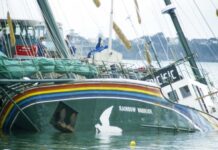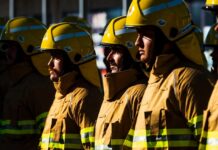The idea of erecting an “Island Closed” sign at Matiatia has gained more than a few social media clicks but Waiheke Local Board is seeking a more measured approach to coping with the tidal wave of tourists drawn to the island.
Board chairman Paul Walden hopes a monitoring programme on the impacts of tourism on the island will begin in 2018, led by Otago University academics and students.
“The monitoring will provide a basis for us to understand what interventions may be required to ensure that our economy is developed more sustainably,” Mr Walden says.
The “monitoring observatory” programme is connected to the United Nations World Tourism Organisation, giving access to experiences and lessons learned in other places that have gone through significant tourism growth, he says. The impacts measured will be both positive and negative and in some cases neutral.
Mr Walden says the information might also advance the case for pursuing UN Biosphere Reserve status for Waiheke. Around the world more than 650 biosphere reserves have been created under the UNESCO (UN Educational, Scientific and Cultural Organisation) umbrella. The status ensures stronger protection for important ecosystems, includes buffer zones for research and education and helps to foster sustainable tourism.
“It would be nice to think that this monitoring programme was supporting and reinforcing the need to establish a UN Biosphere Reserve to provide a more structured mechanism to protect the Hauraki Gulf than what presently exists.”
Local environmentalists and academics behind both the biosphere reserve and monitoring observatory include Pam Oliver, Ivan Kitson, Peter Wills, Chris Palmer, Klaus Bosselman, Prue Taylor, Belinda Robinson, Niki Harré, Steve Poletti and Zack McCracken.
In November, they submitted a discussion paper to the local board highlighting a raft of negative impacts arising from “largely self-regulated and unmonitored tourism development on Waiheke seen by residents as already starting to damage the very features of the island that make it a tourist destination”.
The list included damage to roads by large buses, traffic congestion, infrastructure and maintenance funding and prioritisation, unaffordable rents and houses, homelessness; erratic ferry and bus services and effluent disposal in gulf waters.
Mr Walden says there’s a global trend for tourism to blossom in environments similar to Waiheke with similar consequences, including demand for more workers, more housing and the inability of local government to cope with basic infrastructure needs such as toilets and litter stations.
“We need to be focused on ensuring that we as a community, including business, are collaborating to ensure that looking forward we are working to resolve these issues – because it would be a shame to leave our island and gulf a worse place for future generations.”
He says visitors are attracted to Waiheke for the beautiful environment, “to go out walking on trails or riding a bike or catching public transport and interacting with a passionate and artistic community – as opposed to some activities such as the bottling and sale of water from Waiheke’s aquifers overseas.”
The island’s attributes have been internationally promoted by the Government and regional tourism body ATEED, contributing to its significant growth.
“It’s discomforting to see in the community resistance to the increased number of visitors because, in reality, the benefits from the visitors are not filtering through to the community as they should.
“There are a lot of new people coming to the island with expectations that aren’t necessarily aligned with reality.
“Most certainly, there shouldn’t be an expectation that visitors to the island are a different class to the locals. There’s some sense of that.
“As we’ve been working to reconfigure the pick up and drop off arrangements at Matiatia, the resistance from some tour operators to having visitors experience what we experience every day – by
walking to their vehicle – it’s not appropriate. “Nor should there be an expectation that visitors should be able to have access to endless amounts of water while many locals are left waiting for weeks to get water delivered.”
Mr Walden says capacity issues have been an issue on ferries and for the island’s infrastructure for as long as he can remember.
“In a sense that’s part of the romance of living in one of the world’s most beautiful places and one of the realities that naturally limits the size of our population.”
The local group behind the monitoring observatory proposal is seeking ratepayer funding towards the cost of the programme, which would involve four Otago academics and students visiting the island three times a year. The local board has sought more information on costs. • Geoff Cumming







